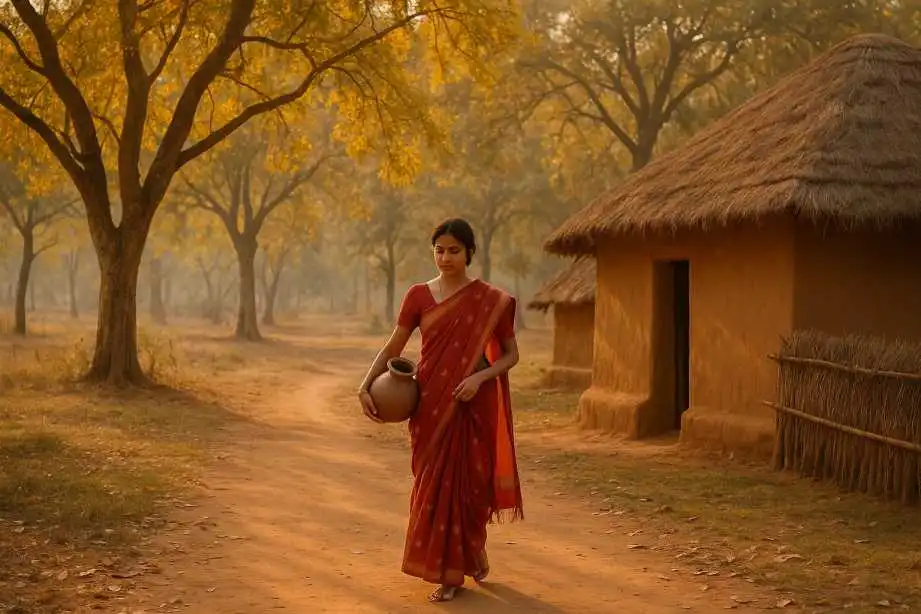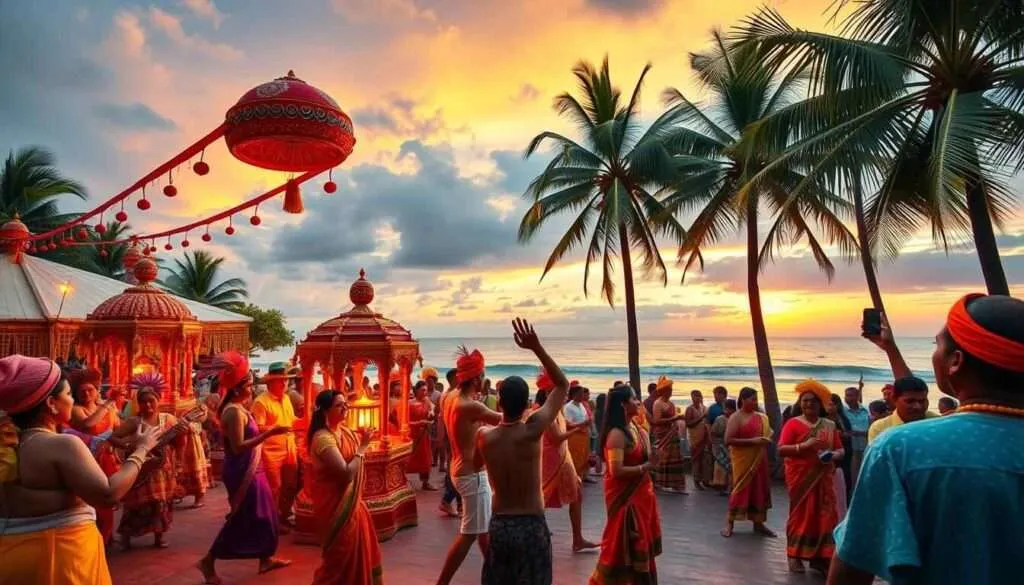More than just a location, Shantiniketan is a tranquil way of life. In Birbhum, West Bengal, this small town invites you to slow your steps and listen: the quiet wind, singing birds, and warm voices around you. There’s no hurry here. Time drifts softly, like clouds over redearth fields.
Visitors find calm under open skies. Locals live simply walking, chatting, and making every moment meaningful. That’s what “slow life” means here: a life lived with care. There’s honesty in everything here nothing is dressed up. People grow their own vegetables, fix their own fences, and wave to each other without needing a reason. No one is trying to impress you. That’s what makes it so good looking and impressive.
This part of Bengal doesn’t just slow you down. It teaches you how much you’ve been missing in your own rush. And once you let go of the need to keep up with the world, you begin to notice your heartbeat again. You notice your breath. You notice life.
Slow Living: What It Means Here?

Here, slow living is not a trend—it’s nature. People walk instead of rushing by car. Meals happen under trees. People walk instead of rushing in vehicles. Children still play outdoors. Elders gather under trees to chat. You can hear birds instead of horns. It’s not about doing less. Stories pass from elder hands to young ears. In Shantiniketan:
- Life is unhurried.
- Work is mindful.
- Silence is welcome.
- Nature is home.
It doesn’t mean doing nothing. It means doing things with intention and presence.
Tagore’s Dream: Learning in Open Air
Rabindranath Tagore dreamed of schools without walls. He built VisvaBharati so students could learn under banyan trees. Books were accompanied by songs, colors, poems, and dance.
- Lessons take place outdoors.
- Creativity matters more than grades.
- Teachers and learners stay as one community.
This concept fashioned a new way to stay—and it nonetheless thrives in every courtyard.
Art in Every Corner
Art is in the soil of Shantiniketan. You will see painted doorways, motifs on walls, handstamped cloths, and sculptures in gardens. Even the stalls in markets show local creativity.
Read Also: Spiritual Gujarat 2025: Hidden Stepwells, Rural Homestays
Local Art You’ll See:
- Alpana patterns on floors and courtyards
- Batik and kantha work on fabrics
- Sculptures at university corners
- Murals with tribal and folk designs
Art blends with life in Shantiniketan. It’s not something extra—it’s how people express themselves every day. Wherever you walk, art speaks—without needing to invite you.
Celebrating Seasons with Soul
Festivals here honor trade in the air—from winter’s kick back to spring’s burst. In Shantiniketan, nature isn’t something human beings get away with on weekends—it’s a part of their regular lifestyles. The converting seasons carry gala's which can be colourful, musical, and deeply rooted in lifestyle.
Festivals Through the Year
|
Festival |
Season |
What Happens |
|
Poush Mela |
December |
Folk songs, crafts, local food |
|
Basant Utsav |
March |
Color, music, poetry in open fields |
|
Barsha Mangal |
July |
Rain songs, monsoon prayers, Tagore tunes |
|
Sharod Utsav |
October |
Dance, drama, Bengali literature |
These are festive and heartfelt—not noisy or crowded.
Weekend Magic: Sonajhuri Haat
Under tall Sonajhuri trees, the weekend market opens. It's with regional music and handcrafted items:
- Baul singers strum ektaras.
- Woven scarves, clay pots, leather bags line the stalls.
- Local snacks and sweets sit on banana leaves.
- Artists paint while visitors stroll by.
This market feels like a story—warm, sensory, alive.
The Red Dust That Stays on Your Feet
It’s funny how the red soil here sticks to your feet—even after you’ve washed them. Locals say it’s not dirt; its memory. The first time I walked through Sonajhuri, I wore sandals. Big mistake. That red dust climbed up my ankles and didn’t leave for days. But after a while, I stopped trying to scrub it off. It felt like proof—I was part of this place, even for a moment.
You see kids kicking up that dust without a care. Women sweep it off their porches every morning, only for it to return by afternoon. It’s everywhere, and somehow, that feels comforting. Like the land is gently reminding you: “You were here. You felt something.”
Not Everything Has a Name Here
There’s a narrow path just behind the old Kala Bhavan building. No signboard. No real reason to walk down it. But one day, I did. A boy passed me holding a bunch of marigolds. On the wall to my right, someone had painted a quote in Bengali that I couldn’t read, but it made me pause anyway.
Related Article: Affordable Kerala Tour Packages for Family: Best Deals with Prices Included
That’s the thing here—so much doesn’t have labels. No Google Maps marker. No "Top 10 things to do in Shantiniketan" list. And maybe that’s the charm. You don’t come here to check things off. You come to get a little lost—and somehow, that’s where you find the most.
People Who Live with Heart
Shantiniketan’s beauty comes from its people. They rise with the sun, take tea slowly, welcome visitors like old friends, and carry poems in their hearts.
- Conversations matter more than routine.
- Music is part of daily life—not just a hobby.
- Guests feel like family.
- Even chores feel like dancing or singing.
People take time to listen—and to be kind.
Quiet Corners to Loiter In
There are cafés and quiet spots that reward slow thoughts:
- Kopi Khor Café—A peaceful spot for coffee and contemplation.
- Prakriti Bhavan—an openair nature museum.
- Chhatimtala—the ground where Tagore meditated.
- Simple homestays—houses with courtyard gardens, local life.
You can spend morning to dusk in one place—just soaking the peace in.
Why People Extend Their Stay?
Most people arrive in Shantiniketan with a return ticket. But somewhere between the second cup of tea and the third quiet sunset, something changes. Days start to blur—in the best way possible. You forget what day it is, and for once, that’s not a problem.
I met a French traveler who came for a week and ended up renting a room for three months. He said it wasn’t the place that made him stay—it was the feeling of not being watched. “Back home, I feel like I have to perform being myself,” he told me. “Here, I can just… be.”
Writers come here and suddenly start finishing pages they’d abandoned. Artists find color again. Retired couples start taking morning walks they never had time for in their cities. Many travel here for a weekend and end up staying for weeks. What draws them in?
- A break from rush and noise.
- Space to write, paint, or think clearly.
- Friendly faces, fresh air, red soil underfoot.
- Affordable living without compromise.
- A peaceful rhythm hard to leave behind.
Some come as tourists. They return as residents of the heart. It’s hard to explain. Even harder to leave it. One woman told me, “It’s not that I have nothing to do here. It’s that nothing here feels forced.” That’s a rare kind of freedom—and once you taste it, rushing back to city life feels unnatural.
Tips to Live the Slow Life Here
You don’t need to overhaul your life. Just open your senses gently.
- Wake early to hear birdsong.
- Walk barefoot on the red soil.
- Sit under a tree—write or draw.
- Shop at the haat—but linger at stalls.
- Share tea with strangers.
- Turn off phones for a while.
Let nature call your name, gently. Let silence speak.
Simple Joys Not to Miss
- A walk down leafy Sonajhuri pathways.
- Listening to Baul tunes at dusk.
- Reading a Tagore poem under mango leaves.
- Tasting rice, dal, mustard fish, and homemade jaggery.
- Watching students paint or sing on campus lawns.
These are moments, not milestones.
What This Town Teaches Us?
Shantiniketan isn’t just a travel spot. I'm a teacher.
- Stillness can be full.
- Less noise doesn’t mean less life.
- Time slows—but the heart stretches.
- Art and nature teach as much as books.
- Kindness matters more than competition.
Here, you don’t just visit—you learn how to be.
Final Thoughts
Shantiniketan isn’t about full schedules or selfie views. It’s about quiet lips, open eyes, and soft hearts. It tells us: Life doesn’t have to race. Small, deliberate measures can lead to its blossoming. Visit once. Walk slowly. Leave with roots in your soul.
In Shantiniketan, Bengal breathes differently—and so can you. Your heart learns a slower, sweeter rhythm to live. I didn’t expect to slow down this much in Shantiniketan. I thought I’d come, look around, take some notes for a blog, maybe buy a few souvenirs and leave. But this place doesn’t let you just visit. It sits with you.
The mornings here are different. No traffic. No alarms. Just birds. I’d wake up, sit with my tea, and stare at nothing. And that nothing started to feel like something. The trees here don’t ask for attention, but somehow you notice them.













